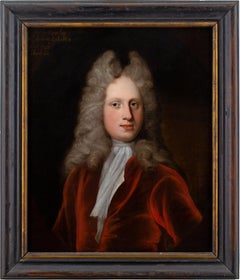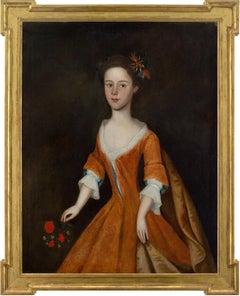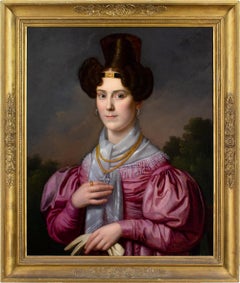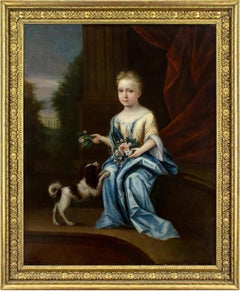Want more images or videos?
Request additional images or videos from the seller
1 of 4
Unknown17th-Century English School, Portrait Miniature Of King Charles I, Oil On Copperc. 1650
c. 1650
$2,540.05List Price
About the Item
- Creation Year:c. 1650
- Dimensions:Height: 6.5 in (16.51 cm)Width: 5 in (12.7 cm)
- Medium:
- Movement & Style:
- Period:
- Condition:As you often see with oil on copper, it presents a little dark. It’s been professionally cleaned. The frame is designed to lean back rather than stand vertical so it can be viewed by looking down. Frame with some light wear.
- Gallery Location:Cheltenham, GB
- Reference Number:1stDibs: LU2328211651602
About the Seller
5.0
Gold Seller
Premium sellers maintaining a 4.3+ rating and 24-hour response times
Established in 2017
1stDibs seller since 2023
248 sales on 1stDibs
Typical response time: 3 hours
Authenticity Guarantee
In the unlikely event there’s an issue with an item’s authenticity, contact us within 1 year for a full refund. DetailsMoney-Back Guarantee
If your item is not as described, is damaged in transit, or does not arrive, contact us within 7 days for a full refund. Details24-Hour Cancellation
You have a 24-hour grace period in which to reconsider your purchase, with no questions asked.Vetted Professional Sellers
Our world-class sellers must adhere to strict standards for service and quality, maintaining the integrity of our listings.Price-Match Guarantee
If you find that a seller listed the same item for a lower price elsewhere, we’ll match it.Trusted Global Delivery
Our best-in-class carrier network provides specialized shipping options worldwide, including custom delivery.You May Also Like
Portrait of King Edward VI, Oil on panel with Gold Leaf, 18th Century English
Located in London, GB
Oil on oak panel
Image size: 25 1/2 x 19 inches (37.5 x 27 inches)
18th Century Auricular gilt frame
Provenance
New York private collection
This portrait of the King Edward VI depicts the boy-king standing in a black and gold embroidered doublet, wearing a jewelled cap. King Edward holds a staff with a globus cruciger set on the table beside him. No expense has been spared in the making of this piece, with gold leaf being applied in many areas to give the effect of the costume's gold embroidery, chain of office and other metal accessories.
As the precious male heir to the Tudor dynasty...
Category
Early 18th Century English School Portrait Paintings
Materials
Gold Leaf
Men portrait with a hat
Located in BELEYMAS, FR
Henry William Pickersgill, attributed to
(London 1782 – London 1875)
Portrait of Captain Samuel Wright
Oil on canvas
H. 92 cm; L. 73 cm
Circa 1810/1815
Provenance:
– Brother of the ...
Category
1810s English School Portrait Paintings
Materials
Oil, Canvas
Circle of John Downman (1750-1824) Portrait Miniature of a Lady c1780 Oil
By John Downman
Located in Holywell, GB
Circle of John Downman (1750-1824) Portrait Miniature of a Lady c1780 Oil on Copper
A delicate English School portrait, dating to c. 1780, of a young lady identified as the Right Ho...
Category
1780s English School Portrait Paintings
Materials
Oil
$1,333
Free Shipping
H 7 in W 5.5 in D 1 in
17th Century Oil Painting Portrait Of Catherine Of Braganza Circle of Peter Lely
Located in Hoddesdon, GB
Catherine of Braganza (1638–1705), Circle of Sir Peter Lely (1618–1680)
Queen consort of England, Scotland, and Ireland, married to King Charles...
Category
17th Century English School Portrait Paintings
Materials
Oil
$19,368
H 57.68 in W 46.46 in D 3.94 in
A Portrait of a Lady
Located in San Francisco, CA
Viewing the delicacy and grace of this portrait, one can appreciate that British artist Rosa Koberwein (1876–1903) was well recognized during her career for producing excellent portr...
Category
Late 19th Century English School Portrait Paintings
Materials
Canvas, Oil
Antique Late 19th Century English Oil on Canvas Painting Female Portrait 1900
Located in Portland, OR
Antique English oil on canvas portrait painting, circa 1900. A very handsome Impressionist portrait of a youthful lady in Edwardian dress. Oil on canvas, signed to the upper left "F ...
Category
Early 1900s English School Portrait Paintings
Materials
Canvas, Oil
$1,900
H 33.25 in W 29.5 in D 2 in
"Anyone for Croquet" Herbert Gustave Schmalz, Portrait by Pre-Raphaelite Artist
Located in New York, NY
Herbert Gustave Schmalz
Anyone for Croquet, circa 1898
Signed lower right
Oil on canvas
47 5/8 x 31 3/4 inches
Provenance
Anthony Mitchell, Nottingham
Burlington Gallery Ltd., Londo...
Category
1890s English School Figurative Paintings
Materials
Canvas, Oil
EARLY / MID 20TH CENTURY English School Oil Painting INTERIOR SELF PORTRAIT
Located in Cirencester, GB
ARTIST: Unsigned (early / mid 20th Century) English School
TITLE: "Self Portrait In A Round Mirror"
SIGNED: appears unsigned
MEDIUM: oil on canvas
SIZE: 73cm x 62cm inc frame
CONDIT...
Category
Early 20th Century English School Interior Paintings
Materials
Oil
$777
H 28.75 in W 24.41 in D 2.76 in
Portrait After John Constable, Sotheby's Provenance
By John Constable
Located in New York, NY
After John Constable (British, 1776-1837)
Portrait of A Man, c. 1800
Oil on canvas
23 3/4 x 19 3/4 in.
Framed: 34 x 29 3/4 x 2 3/4 in.
Sotheby'...
Category
19th Century English School Portrait Paintings
Materials
Canvas, Oil
Sir Francis Dicksee Portrait, c. 1900
Located in New York, NY
Sir Francis Dicksee (English, 1853-1928)
Untitled (Portrait of a Woman), c. 1900
Oil on canvas; period frame
Sight: 13 1/4 in.
Framed: 21 1/8 x 21 1/8 x 3 3/8 in.
Frank Dicksee was a member of a noted artistic family, his father, brother, and sister Margaret were all well-known painters, and the family lived in the Bloomsbury area of London. He was initially trained by his father, before entering the Royal Academy schools in 1870. Amongst the visiting lecturers who trained him, were the famous senior academicians Leighton [1830-1896] and Millais [1829-1896].
Dicksee was a star student, earning many distinctions and medals. Like many other artists of the day his early career was largely spent in book illustration, as well as some stained glass window design. He started exhibiting at the RA in the mid 1870s, and also exhibited at the Grosvenor Gallery, though his real base was always the Academy. Dicksee made his reputation with Harmony, exhibited at the Academy in 1877, and bought by the Chantry Bequest.
Frank Dicksee was elected ARA in 1881, and became a full RA ten years later. Many of his pictures were of dramatic historical and legendary scenes. He also was a noted painter of elegant, highly-finished portraits of fashionable women, which of course helped to bring him material success. Many of these portraits are so beautiful, it is really difficult to disapprove of them - happy was the fashionable lady whose portrait was painted by Dicksee! He also painted landscapes.
Dicksee lived in St John's Wood, and remained a bachelor. He was, of course, one of the nineteenth century artists who outlived his time, and was, to his credit, very unhappy with developments in the early twentieth century. Rather surprisingly, Dicksee was elected President of the Royal Academy in 1924, fulfilling the role with panache and tact. Physically he was a tall, good-looking, patrician figure, with a charming easy-going manner. Like his predecessor but one Edward Poynter...
Category
Early 1900s English School Portrait Paintings
Materials
Oil, Canvas
$14,500
H 21.125 in W 21.125 in D 3.375 in
More From This Seller
View AllMichael Dahl (Circle), Portrait Of Thomas Stanley
Located in Cheltenham, GB
This early 18th-century English School portrait depicts Thomas Stanley wearing a striking red velvet suit, white cravat and powdered periwig. Fashionable, yet elegantly refined. On t...
Category
Early 18th Century English School Portrait Paintings
Materials
Oil, Canvas
Mid-18th-Century English School, Portrait Of A Girl With A Posy
Located in Cheltenham, GB
This exceedingly charming mid-18th-century English oil painting depicts a girl wearing a red gown with a train over a white petticoat. She’s holding a posy or nosegay.
Evidently once commissioned for an English country house, the identity of this young lady remains a mystery. Her gown appears to be inspired by the popular ‘robe à la française...
Category
1740s English School Portrait Paintings
Materials
Oil, Canvas
Franz Xaver Winterhalter (Circle), Portrait Of A Lady In A Pink Dress
By Franz Xaver Winterhalter
Located in Cheltenham, GB
This charming early 19th-century oil painting by an artist influenced by Franz Xaver Winterhalter (1805-1873) depicts a lady wearing a pink dress with gigot sleeves and a crucifix. S...
Category
1830s Naturalistic Portrait Paintings
Materials
Oil, Canvas
John Verelst (Circle), Portrait Of A Young Lady With A Spaniel
By John Verelst
Located in Cheltenham, GB
This large early 18th-century full-length portrait depicts a seated young lady before a classical column and distant country house. It was formerly in the collection of Dalham Hall i...
Category
Early 18th Century Rococo Portrait Paintings
Materials
Oil, Canvas
Jean Baptiste Discart, Portrait Of A Lady With A Yellow Rose
Located in Cheltenham, GB
This fine late 19th-century portrait by renowned Italian artist Jean Baptiste Discart (1856-1944) depicts a lady wearing a black dress embellished with a lace collar, together with a single yellow rose. It’s catalogued (#3) in Theo P.G. Kralt’s book, Jean Baptiste Discart, Orientalist Paintings and Dutch Portraits.
A provocative rose draws one’s eye to the ‘décolletage’. Was it her idea or the bold suggestion of a young Discart, just 21, and bursting with energy? The style of dress came to the fore during the late 19th century and was regarded as somewhat improper by a stoic older generation. But, of course, the glaring eyes only encouraged young ladies to rebel and adopt the fashion regardless.
Little is known about the sitter, but it’s conceivable that she’s either Austrian or French, given Discart’s known locations in 1879. It was completed during his training. It bears all the hallmarks of a young and confident painter looking to establish himself.
Born in Modena, Italy, Discart’s father, Francesco Ferdinando, moved in particularly distinguished circles and worked for the Duke of Modena. Indeed, the Duke became young Jean’s godfather, so the pair were well-connected. One can only imagine the ostentatious interiors that he witnessed during childhood, and it’s conceivable that these experiences inspired his appreciation for the finer things in life.
At 14, he was enrolled at the Academy of Fine Arts in Vienna, where he trained under the German painter, Anselm Feuerbach (1829-1880). It seems that he stayed here until Feuerbach’s retirement in 1877 when the course was handed over to Leopold Carl Müller (1834-1892). His short time under Müller, known for his exquisite ‘orientalist’ work, would be transformative.
From here, he left Vienna to immerse himself in the cosmopolitan environs of the French Capital and exhibited at the Paris Salon in 1884. At that point in time, Paris was an exciting place for an emerging artist. In 1884, the Société des Artistes Indépendants held their first show, which included works by Paul Cézanne...
Category
Late 19th Century Victorian Portrait Paintings
Materials
Oil, Canvas
Mid-19th-Century French School, A Pair Of Nanas, 2 x Oil Paintings
Located in Cheltenham, GB
This charming pair of mid-19th-century French School portraits depicts two grandmothers, both presumably widows, wearing black gowns and white bonnets.
Alas, the identity of these r...
Category
Mid-19th Century Portrait Paintings
Materials
Oil, Canvas
Recently Viewed
View AllMore Ways To Browse
Portrait King Charles
17th Century Portrait Of A Gentleman
Antique Miniature Oil Paintings
17th Century English Portraits
Miniature Oil Portrait
Portrait Of Charles I
Miniature 17th Century Portraits
Textured Paintings Portraits
18th Century English Portrait
Early American Portrait Paintings
Victorian Oil Portrait Black
Charles Lutz Warhol Denied
Original 19th C Portrait Of Black
Warhol Denied
1930s Oil Portraits
George Founds
Portrait Children Paintings
Portrait Painting Young Boy



